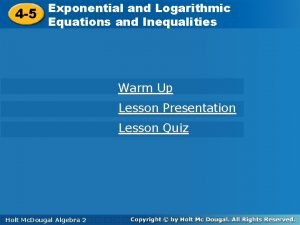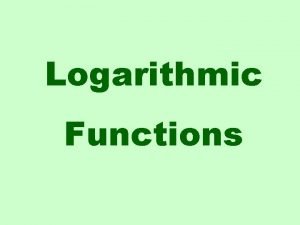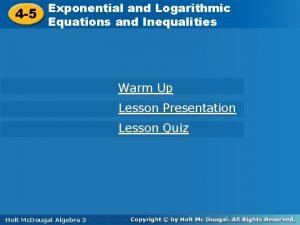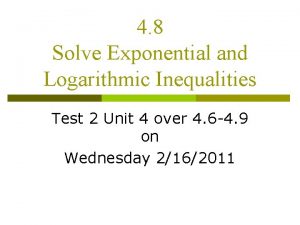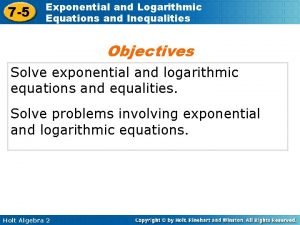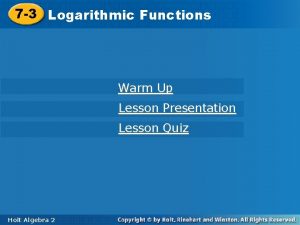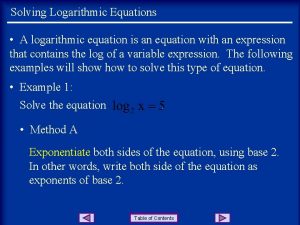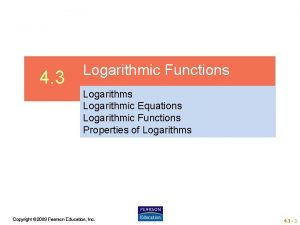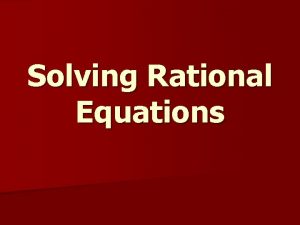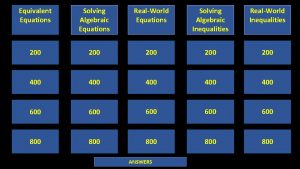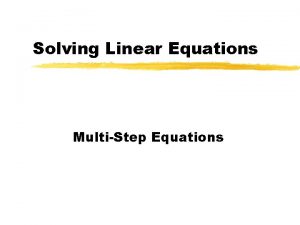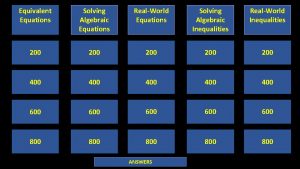Solving Logarithmic Equations A logarithmic equation is an











- Slides: 11

Solving Logarithmic Equations • A logarithmic equation is an equation with an expression that contains the log of a variable expression. The following examples will show to solve this type of equation. • Example 1: Solve the equation . • Method A Exponentiate both sides of the equation, using base 2. In other words, write both side of the equation as exponents of base 2. Table of Contents

Solving Logarithmic Equations Original problem Exponentiate Use inverse property to simplify … Evaluate the exponential … Table of Contents

Solving Logarithmic Equations • Method B Original problem Use the definition of a log to express the equation in exponential form. Evaluate the exponential … Table of Contents

Solving Logarithmic Equations • Example 2: Solve the following equation. Get the log expression on the left side by itself. Note that ln is a log with base e. Table of Contents

Solving Logarithmic Equations Method A Method B Table of Contents

Solving Logarithmic Equations • Example 3: Solve the following equation (nearest hundredth). Use the Product property to combine the logs. Note that “log” is a log with base 10. Now either exponentiate (Method A) or use the definition of a log (Method B) to get … Table of Contents

Solving Logarithmic Equations Use the quadratic formula to solve for x. Written as decimals (nearest hundredth), the solutions are. . . Table of Contents

Solving Logarithmic Equations • Go back and look at the original equation and compare with the answers. • Note that for the solution x = - 5. 36, the expressions (x - 2) and (x + 4) will both be negative. Since the logarithm of a negative number is undefined, we must throw this extraneous solution out. • The solution to the equation is Table of Contents

Solving Logarithmic Equations • Example 4: Solve the following equation. Use the Quotient property to combine the logs on the left hand side of the equation. Equating the two expressions yields. . . Table of Contents

Solving Logarithmic Equations Solve for x. Table of Contents

Solving Logarithmic Equations Table of Contents
 Chapter 4 exponential and logarithmic functions answer key
Chapter 4 exponential and logarithmic functions answer key Example of logarithmic inequality
Example of logarithmic inequality Indices problem solving
Indices problem solving Natural log to exponential form
Natural log to exponential form 7-5 exponential and logarithmic equations
7-5 exponential and logarithmic equations Logarithmic inequality example
Logarithmic inequality example Exponential function calculator
Exponential function calculator Graphing exponential inequalities
Graphing exponential inequalities Property of equality for logarithmic equations
Property of equality for logarithmic equations Modeling with exponential and logarithmic equations quiz
Modeling with exponential and logarithmic equations quiz 7-5 exponential and logarithmic equations
7-5 exponential and logarithmic equations Quiz 7-2 logarithmic expressions and functions
Quiz 7-2 logarithmic expressions and functions

